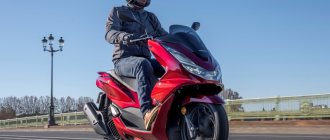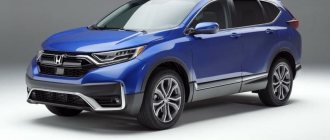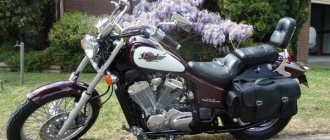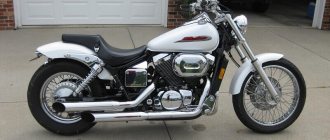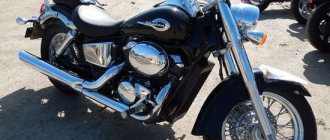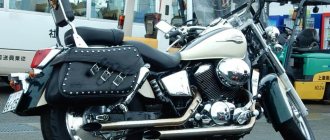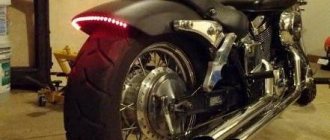| Honda VT1100 Shadow | Honda VT1100 Shadow | Honda VT1100 Shadow |
Cruiser model Honda VT1100 Shadow
appeared in 1985 on the American market.
In those years, the model was distinguished by high power (78 hp), double front disc brakes and a hydraulic clutch. The factory model designation is VT1100C
. Since 1987, the motorcycle has been updated externally and technically - the wheelbase has been increased, the mufflers on the sides have been moved to the right side, the maximum power is reduced (to 67 hp), the operating speed is significantly reduced, which increases traction at the “lower” and “middle” ", the hydraulic clutch gives way to a cable clutch. It was with this modification that the popularity of the Honda VT1100 Shadow model began - the 1985-1986 versions are quite rare.
Main modifications of the Honda VT1100 Shadow
:
- Honda VT1100C Shadow
(1987-1996) - the basic version of the motorcycle. Features alloy wheels, dual right exhaust, 13 liter fuel tank, 4-speed gearbox and rear drum brake. - Honda VT1100C Spirit
(1997-2007) is the successor to the previous modification. Visually very similar to its predecessor. It differs in the shape of the exhaust, tank and some visual features. Among the technical differences, it is worth noting the fuel tank increased to 15.8 liters and a 5-speed gearbox. - Honda VT1100C2 ACE
(1995-1999) is a classic version of the motorcycle. ACE stands for American Classic Edition. The model features spoked wheels, extended fenders, wider wheels, a rear disc brake, a single-rack crankshaft (to increase vibrations) and 53 hp. - Honda VT1100T ACE Tourer
(1998-2001) - touring version of the previous modification. It is distinguished by the presence of plastic panniers, a windshield, alloy wheels, an exhaust system on the sides and other wheels. - Honda VT1100C3 Aero
(1998-2002) - similar to the ACE version, but with deeper fenders, a larger headlight and a 2-into-1 exhaust. - Honda VT1100C2 Saber
(2000-2007) - similar to the ACE version, but with a Spirit engine and specially shaped alloy wheels.
In 2003, only the basic version VT1100C Spirit and VT1100C2 Saber remained on the market, which were offered almost unchanged until 2007 inclusive, after which they were completely discontinued, completely giving way to the model - Honda VTX 1300.
Model range of the Honda Shadow series:
- Honda Shadow 400
- Honda Shadow 600
- Honda Shadow 750
- Honda Shadow 1100
The main competitors of the Honda Shadow 1100 in the class:
- Yamaha XV 1100 Virago / Yamaha XVS 1100 Drag Star
- Kawasaki VN1500 (Vulcan 88, VN-15)
Brief history of the model
- 1985 - start of production and sales of the Honda VT1100 Shadow model.
Model
: Honda Shadow 1100 (USA).
Code
: VT1100C / VT1100C AC
- 1986 - no significant changes.
Model
: Honda Shadow 1100 (USA).
Code
: VT1100C / VT1100C AC
- 1987 - the model undergoes significant changes (see the beginning of the review).
Model
: Honda Shadow 1100 (USA, Canada).
Code
: VT1100C / VT1100C AC, VT1100CH
- 1988 - The Honda VT1100C Shadow model appears in Europe.
Model
: Honda Shadow 1100 (USA, Canada, Europe).
Code
: VT1100C / VT1100C AC, VT1100CJ
- 1989 - Model available only in the USA.
Model
: Honda Shadow 1100 (USA).
Code
: VT1100C / VT1100C AC
- 1990 - no significant changes.
Model
: Honda Shadow 1100 (USA).
Code
: VT1100C / VT1100C AC
- 1991 - model not for sale.
- 1992 - Model available in the USA and Canada.
Model
: Honda Shadow 1100 (USA, Canada).
Code
: VT1100C / VT1100C AC, VT1100CN
- 1993 - no significant changes.
Model
: Honda Shadow 1100 (USA, Canada).
Code
: VT1100C / VT1100C AC, VT1100CP
- 1994 - The model is again available in Europe.
Model
: Honda Shadow 1100 (USA, Canada, Europe).
Code
: VT1100C / VT1100C AC, VT1100CR
- 1995 - appearance of the ACE modification - American Classic Edition.
Model
: Honda Shadow 1100, Honda Shadow 1100 ACE (USA, Canada, Europe).
Code
: VT1100C/VT1100C AC, VT1100CS, VT1100C2/C2S
- 1996 - no significant changes.
Model
: Honda Shadow 1100, Honda Shadow 1100 ACE (USA, Canada, Europe).
Code
: VT1100C/VT1100C AC, VT1100CT, VT1100C2/C2T
- 1997 - The base version receives several technical and visual changes and also changes its name in the United States to the Honda VT1100C Spirit.
Model
: Honda Shadow 1100 Spirit, Honda Shadow 1100 ACE (USA, Canada, Europe).
Code
: VT1100C/VT1100C AC, VT1100CV, VT1100C2/C2V
- 1998 - appearance of modifications ACE Tourer and VT1100C3 Aero.
Model
: Honda Shadow 1100 Spirit, Honda Shadow 1100 ACE / ACE Tourer, Honda Shadow 1100 Aero (USA, Canada, Europe).
Code
: VT1100C / VT1100C AC, VT1100C2-2A, VT1100C2W, VT1100T, VT1100C3W
- 1999 - no significant changes.
Model
: Honda Shadow 1100 Spirit, Honda Shadow 1100 ACE / ACE Tourer, Honda Shadow 1100 Aero (USA, Canada, Europe).
Code
: VT1100C / VT1100C AC, VT1100C2, VT1100C3 AC, VT1100C2X, VT1100T, VT1100C3X, VT100D2
- 2000 - appearance of the VT1100C2 Saber modification.
Model
: Honda Shadow 1100 Spirit, Honda Shadow 1100 ACE Tourer, Honda Shadow 1100 Aero, Honda Shadow 1100 Saber (USA, Canada, Europe).
Code
: VT1100C / VT1100C AC, VT1100C2Y, VT1100C2 AC, VT1100C3 / C3Y, VT1100T
- 2001 - Model no longer available in Europe. Start of sales in Australia.
Model
: Honda Shadow 1100 Spirit, Honda Shadow 1100 ACE Tourer, Honda Shadow 1100 Aero, Honda Shadow 1100 Saber (USA, Canada, Australia).
Code
: VT1100C/VT1100C AC, VT1100C2/C2 AC/C21, VT1100C3/C31, VT1100T
- 2002 - ACE modifications are no longer offered.
Model
: Honda Shadow 1100 Spirit, Honda Shadow 1100 Aero, Honda Shadow 1100 Saber (USA, Canada, Australia).
Code
: VT1100C/VT1100C AC, VT1100C2/C2 AC/C22, VT1100C3/C3 AC/C32
- 2003 - Aero modification is no longer offered.
Model
: Honda Shadow 1100 Spirit, Honda Shadow 1100 Saber (USA, Canada, Australia).
Code
: VT1100C / VT1100C A / VT1100C AC, VT1100C2 / C2 AC/ C2 A / C23
- 2004 - no significant changes.
Model
: Honda Shadow 1100 Spirit, Honda Shadow 1100 Saber (USA, Canada, Australia).
Code
: VT1100C / VT1100C A / VT1100C AC, VT1100C2 / C2 AC/ C2 A / C24
- 2005 - no significant changes.
Model
: Honda Shadow 1100 Spirit, Honda Shadow 1100 Saber (USA, Canada, Australia).
Code
: VT1100C / VT1100C A / VT1100C AC, VT1100C2 / C2 AC/ C2 A / C25
- 2006 - Model available only in the USA.
Model
: Honda Shadow 1100 Spirit, Honda Shadow 1100 Saber (USA).
Code
: VT1100C / VT1100C A / VT1100C AC, VT1100C2 / C2 AC/ C2 A
- 2007 is the last year of production.
Model
: Honda Shadow 1100 Spirit, Honda Shadow 1100 Saber (USA).
Code
: VT1100C / VT1100C A / VT1100C AC, VT1100C2 / C2 AC/ C2 A
Features (advantages and disadvantages)
“Smooth” is how the Shadow 1100 from Honda can be briefly described. There are no particularly outstanding qualities in it, just as there are no significant shortcomings or obvious flaws.
The model does not have many distinctive features.
- Hydraulic compensators allow the owner to practically not bother with maintenance.
- This also includes a good cardan - having a dozen dampers, it extends the life of the gearbox, and does not require maintenance itself - just add oil.
- "Eternal" motor.
- Availability of new and used parts at American/Japanese flea markets.
- Landing characteristic of the class.
- A pair of springs on the rear shock absorber, most users note that when traveling with two people it is a bit soft, there is a danger of breaking through.
The owners noted that if the motorcycle is not purposefully killed, it will serve for a long time, but if maintenance is necessary, it is still better to trust a specialist.
Specifications
Technical characteristics of Honda Shadow 1100:
| Model | Honda VT1100 Shadow |
| Motorcycle type | cruiser |
| Year of issue | 1985-2007 |
| Frame | steel |
| engine's type | 2-cylinder, 4-stroke, V-shaped |
| Working volume | 1099 cm³ |
| Bore/Stroke | 87.5 x 91.4 mm |
| Compression ratio | 9.0:1 – VT1100C (1985-1986) 8.5:1 – VT1100C (1987-1996) 8.0:1 – VT1100C (1997-2007), VT1100C2, VT1100C3, VT1100T |
| Cooling | liquid |
| Number of valves per cylinder | SOHC, 3 valves per cylinder (with hydraulic lash adjusters) |
| Fuel supply system | carburetor, 2x Keihin CV36 |
| Ignition type | transistor |
| Maximum power | 78 hp (58 kW) at 6000 rpm – VT1100C (1985-1986) 67 hp (49 kW) at 5500 rpm – VT1100C (1987-2007) 53 hp (39 kW) – VT1100C2, VT1100T |
| Maximum torque | 101 Nm (10.1 kgm) at 4500 rpm – VT1100C (1985-1986) 91 Nm (9.27 kgm) at 2700 rpm – VT1100C (1987-2007) 88 Nm (8.9 kgm) at 2700 rpm – VT1100C2, VT1100T |
| Clutch | Multi-disc in an oil bath, cable drive - VT1100C (since 1997) and other versions Multi-disc in an oil bath, hydraulic drive - VT1100C (until 1997) |
| Transmission | 5-speed – VT1100C (1985-1986), VT1100C (1997-2007), VT1100C2, VT1100C3, VT1100T 4-speed – VT1100C (1987-1996) |
| type of drive | cardan |
| Front tire size | 110/90-18 61H – VT1100C (1985-1986) 110/90-19 62H – VT1100C (1987-2007) 120/90-18 65H – VT1100C2 130/80R-18 66H – VT1100T |
| Rear tire size | 140/90-15 70H – VT1100C (1985-1986) 170/80-15 M/C 77H – VT1100C (1987-2007), VT1100C2 170/70R-16 75H – VT1100T |
| Front brakes | 2 discs, 269 mm, 2-piston calipers – VT1100C (1985-1986) 1 disc, 316 mm, 2-piston calipers |
| Rear brakes | drum – VT1100C 1 disc, 276 mm, 1-piston caliper – VT1100C2 / C3, VT1100T |
| Front suspension | 41 mm telescopic fork, travel - 150 mm |
| Rear suspension | pendulum with two shock absorbers (preload adjustment), stroke - 100 mm |
| Motorcycle length | 2325 mm – VT1100C (1985-1986) 2376 mm – VT1100C (1987-1996) 2380 mm – VT1100C (1997-2007) 2435 mm – VT1100C2 2485 mm – VT1100T |
| Motorcycle width | 810 mm – VT1100C (1985-1986) 791 mm – VT1100C (1987-1996) 880 mm – VT1100C (1997-2007) 965 mm – VT1100C2, VT1100T |
| Motorcycle height | 1230 mm – VT1100C (1985-1986) 1200 mm – VT1100C (1987-1996) 1220 mm – VT1100C (1997-2007) 1160 mm – VT1100C2 1430 mm – VT1100T |
| Wheelbase | 1610 mm – VT1100C (1985-1986) 1651 mm – VT1100C (1987-1996) 1650 mm – VT1100C (1997-2007), VT1100C2 1655 mm – VT1100T |
| Seat height | 750 mm – VT1100 (1985-1986) 660 mm – VT1100 (1987-1993) 690 mm – VT1100 (1994-1996) 730 mm – VT1100 (1997-2007) |
| Minimum ground clearance (clearance) | 150 mm |
| Acceleration 0-100 km/h (0-60 mph) | 5.76 sec[1] |
| Maximum speed | 161 km/h[2] |
| Gas tank capacity | 15.0 l – VT1100C (1985-1986) 13.0 l – VT1100C (1987-1996) 15.8 l – VT1100C (1997-2007), VT1100C2, VT1100C3, VT1100T |
| Motorcycle weight (dry) | 245 kg – VT1100C (1985-1986) 242 kg – VT1100C (1987-1996) 251 kg – VT1100C (1997-2007) 260 kg – VT1100C2 284 kg – VT1100T |
Tuning VT 1100
Most Honda VT 1100 Shadow Aero, Spirit and others are modified by their owners based on their needs - some prefer a “hooligan” urban style, while others turn their bike into a real kilometer eater. Fortunately, a lot of tuning for this model is sold - saddlebags, windshields, seats, chrome packages, lighting optics, levers, reinforced brakes... But it is worth noting that, thanks to a fairly simple design, the process of customizing this steel horse “for yourself” is not particularly difficult labor.
Reviews
Reviews about Honda Shadow 1100:
Expand Collapse
The most common breakdowns are pockets of corrosion on the cylinders, which arise as a result of improper engine preservation or its complete absence. This happens to Americans very, very often. Another infection that may contribute to this is sinks on cylinders (which is also relatively common on American-made “Japanese”).
It’s not all that bad; it can be treated by simply boring the cylinders and replacing the pistons, rings and gaskets. The asking price is about 13,000 without the work of assembling and disassembling the motor and removing/installing it. At least for some reason the percentage of “broken” ones is the highest among 1100 fans, this is an observation.
Other breakdowns are either a consequence of the owner’s carelessness, or the systematic killing of the engine, or the consequences of falls (oil starvation, if the engine does not stall immediately) or factory defects. In my practice, I came across only one defect (more precisely, its consequence) - a small metal scuff on the contact surface of the rocker arm. Discovered by accident, it did not bring any consequences to the motor.
The motor is relatively repairable, but experience is needed so as not to make any mistakes. Its only real drawback is that the main bearings do not change. Only together with the crankcase. Crankshafts too, just replacement.
Scheduled work - changing oil, filters, cleaning and synchronizing carbs, checking compression. No ignitions, valves, sprocket chains, etc. Well, the conditions for repair work need to be very suitable - a bunch of measuring tools, a dynamometer, wrenches. I’m silent about the garage itself - warmth, light, workbench and cleanliness - it goes without saying.
The engine resource is very large. This is inherent in its design. The motors are very durable. I can’t tell you exact numbers, but I think it’s quite capable of going through 200-250 thousand before signs of systematic wear and tear. The motor is fully automatic. Automatic chain tensioners (like Steed), hydraulic compensators for rocker arm axles. And at the same time not a single unnecessary detail.
Gearbox, clutch, transmission - it’s all very difficult to ruin. The gearbox is simple and reliable. 5 steps, very clear work. The clutch is like a Steed, only larger. The clutch is driven by a cable, a little tight, but in moderation. Very informative, with the exact moment of operation. The motor transmission is like a Steed, with gears (oh, and howls constantly, 1100 after all, such a pleasant sound, look at the videos on YouTube). Rear drive is by cardan. There are a lot of dampers throughout the drive, which greatly simplifies the life of the gearbox.
For spare parts - all any spare parts for the 1100 are available for sale in the USA, on eBay and from other suppliers
I had a motorcycle like this. I've been away for three years. Was born in '93. I bought it with 7 thousand miles. In three years, except for a torn gas return cable, NOTHING has broken. Oil, filters, pads... Of the minuses, IMHO, the rear suspension is a bit soft for two, the choice of gear ratios in the gearbox is strange, in my opinion, and that’s about it.
Features of the release (prices)
Although many publications write that the 750 version was born earlier, and therefore it is the ancestor, it is worth noting that it entered the line only after the renaming in 1986 . She started under a different name.
The liter model spent only a year alone; in 1987 and beyond, the development of “shadows” with different engine sizes began, many of the solutions for which were taken from here - from the liter. This largely explains their indestructibility.
But the liter also had features that were not developed in subsequent motorcycles. They will be discussed below. The model lived on the assembly line until 2007 . The price on the secondary market is not much more than its less cubic capacity counterparts - $3,500 , without mileage in the Russian Federation, 165,000 rubles with mileage.
Landing
In general, landing is an individual concept. For some reason, it turned out to be terribly uncomfortable for me to sit on the Valkyrie 1500. However, the riding position on this motorcycle is comfortable. It should be convenient, if we remember that our task is to travel far and the goal is to travel rather than “get there faster.”
For a person who has never sat on such a motorcycle, I can suggest that you sit in a regular office or computer chair, stretch your legs horizontally, lower them to the floor and slightly pull them towards you so that your feet completely touch the floor, but it does not seem that you are pulling somewhere with your legs . That's basically all.
As for the width of the steering wheel... people often change the steering wheel to suit themselves (as well as the seat), but the general principle is this: imagine that cute twins with size 4 are standing close to each other in front of you. Take them by the extreme si, in general they took them. Now stop dreaming, clench your hands as expected and lower your arms parallel to the floor. If you didn't kick your legs during the process, congratulations, this is the right pose.
So who are you finally?
To summarize, the Honda Shadow Saber is a “blank” motorcycle (don’t be offended by this name, there is no negative connotation here), a motorcycle that is popularly called a “chopper” (although from the point of view of chopper engineering, it is by no means a chopper) or a cruiser, which is much closer in essentially. This is a motorcycle that can be customized specifically to suit your needs. This is a bike for those who want a Harley but don't want a Harley and maybe want practicality. This is a motorcycle for those who take 2 wheels not to be on time somewhere, not for the sake of adrenaline, not for the opportunity to go where wolves are afraid to shit, but simply for the opportunity to go. This is a motorcycle that combines a chopper-cruiser image with Honda reliability and practicality.
This is my motorcycle and I'm glad I own it.
Fuel consumption
Officially indicated in the papers, the fuel consumption from the manufacturer for the Honda VT1100 Shadow is 5.2 liters for every 100 km of distance traveled. In practice, it comes out to at least one liter more, and the exact fuel consumption value depends on your driving style and manner and the quality of the fuel.
But as a rule, fuel consumption on such motorcycles is close to the declared one. After all, such devices are bought for measured travel in harmony with oneself, and not for crazy races from traffic lights to the squeal of rubber skidding on the asphalt.
Main modifications of the Honda VT1100 Shadow:
Honda VT1100C Shadow (1987-1996) - the basic version of the motorcycle. Features alloy wheels, dual right exhaust, 13 liter fuel tank, 4-speed gearbox and rear drum brake.
Honda VT1100C Spirit (1997-2007) is the successor to the previous modification. Visually very similar to its predecessor. It differs in the shape of the exhaust, tank and some visual features. Among the technical differences, it is worth noting the fuel tank increased to 15.8 liters and a 5-speed gearbox.
Honda VT1100C2 ACE (1995-1999) is a classic version of the motorcycle. ACE stands for American Classic Edition. The model features spoked wheels, extended fenders, wider wheels, rear disc brakes, a single-rack crankshaft (to increase vibrations) and 53 hp.
Honda VT1100T ACE Tourer (1998-2001) - touring version of the previous modification. It is distinguished by the presence of plastic panniers, a windshield, alloy wheels, an exhaust system on the sides and other wheels.
Honda VT1100C3 Aero (1998-2002) - similar to the ACE version, but with deeper fenders, a larger headlight and a 2-into-1 exhaust.
Honda VT1100C2 Saber (2000-2007) - similar to the ACE version, but with a Spirit engine and specially shaped alloy wheels.
In 2003, only the basic version VT1100C Spirit and VT1100C2 Saber remained on the market, which were offered almost unchanged until 2007 inclusive, after which they were completely discontinued, completely giving way to the model - Honda VTX 1300.
Not luxury =(
Due to the fact that the image set by Harley has acquired “cruising” capabilities, many such useful things are missing in such motorcycles. I don’t want to chase luxury tourers and their equipment, but a banal cigarette lighter and heated grips in the factory trim for a cruiser would be a very reasonable solution. However, this is not only nitpicking, but I also have plans, and some of them have already been implemented - for example, the same cigarette lighter. Although it would certainly be nice to have another key position where some electrics would be turned on, the key can be removed. Or ABS.. Oh, dreams.
Actually, there are a minimum of basic equipment. Consider for yourself what I have:
- speedometer (in miles and kilometers)
- odometer (miles)
- odometer - “current trip” (in miles)
And indicators:
- high temperature
- little oil
- neutral (at the base of the steering wheel)
- turn signals (at the base of the steering wheel, not visible in the photo)
- high beam (at the base of the steering wheel, not visible in the photo)
And that is all. Although there is a lot of useful equipment for traveling, the same pressure (puncture) sensors in tires.
Thus, a cruiser, which is not a luxury tourer, is more of a motorcycle for “just riding” rather than a device for serious troubles. All this is very conditional, it would be stupid not to drive it somewhere far since, as you can see, it doesn’t have puncture sensors. People don't even drive like that. But this is the concept, and if you want to have this technique, you will have to accept it.
Cruiser?
Cruiser , or cruiser (English cruiser) is a type of motorcycle.
The name comes from the English word cruise/cruising, which means “to cruise”, “to follow a course”, “to travel with the purpose of traveling”. It is characterized by a low seat, an upright seating position, often far forward footrests, an abundance of chrome and significant weight. The cruiser is not designed for fast driving or off-road driving; its engine usually does not have high power, but it has light and comfortable handling, high torque at low speeds and an appropriately “menacing” sound.
So, a big cruiser is a motorcycle for the road. Moreover, for roads in the most romantic sense of this meaning. You can experience the pleasure of owning it as such, you can enjoy the sound of the engine, the luggage space, the chrome, in a word, anything, but the further the road goes from the “romantic ideal”, the less you will be happy with this motorcycle. What is the ideal of the road? This is easy to explain with a picture:
I couldn’t find a better one, but I think you understand me anyway. Nevertheless, I will say - a big cruiser is (what a surprise) a motorcycle for a long road, for a highway that reaches the horizon.
And don't think I'm talking about American highways. No, we also have excellent roads.
highway M-4 "Don"
But as soon as the quality of the road becomes poor (and we have a lot of such roads outside federal highways), or you find yourself in heavy traffic (I live in Moscow, for me heavy traffic is the norm of life) - you will not experience the pleasure of the trip.
All the best is for the Yankees!
Reinterpreting the famous statement of the classic of Marxism-Leninism, Japanese managers can rightfully claim: “The most important of all markets for us is the American one!”
Vestimo: this glutton swallows the lion's share of large-capacity motorcycles produced all over the world, and it is these mastodons that bring the largest profits to concerns (“making a bigger hole is a simple matter... Well, okay, okay, I’m exaggerating this...). Therefore, the tastes and even the whims of the American consumer are satisfied immediately and unquestioningly. Knowing the Americans' passion for V-shaped engines, Honda engineers designed a family of V4 engines, which appeared in the fall of 1981 in the chassis of the classic Saber motorcycles and the choppered Magna. But here’s the problem: there were picky people in USA who, when they saw the new products, roared: “I want a V-Twin!” The confused Japanese wiped the fools' snot, but did not argue: just a year later they rolled out a family of Shadow cruisers (translated from English as “shadow”) with the coveted 2-cylinder engine. True, they did not immediately understand the mysterious American soul, and the new products turned out to be simply “high-tech” by the standards of that time: with liquid cooling (disguised by the abundant fins of the cylinders), 3-valve heads, 6-speed gearboxes, cast wheels and a cardan main transmission.
At first, the Japanese produced “twos” only in 500 and 750 cm3 formats, believing that lovers of large cubic capacity would be quite satisfied with the 4-cylinder 1100 cc Magna. No matter how it is! The Americans considered its 120-horsepower engine more suitable for sports bikes and demanded: “Give me something Harley-like!” The specialists from Honda again did not object. The VT1100C Shadow version was launched in 1985, and its assembly was organized at a plant in the USA: at that time, draconian duties were in effect on the import of motorcycles with engines with a displacement of more than 700 cm3 (adopted to save Harley-Davidson, which was losing its position in the market). Technically, the car retained the features of its younger sisters: liquid cooling, 3-valve cylinder heads, cardan transmission.
And only much later the time came for small cubic capacity V-Twins, which were no longer supplied to America (well, they don’t respect small things in the country!). In 1993, the 250 cc V25 Magna, intended only for the Japanese market, debuted (its copy, by the way, is produced by several Chinese and Taiwanese factories), and in 1998, the 125 cc version of the Shadow, which instantly became a bestseller on the European market. But technically, these machines are very different from motorcycles of medium and large capacity, and we will not touch on them in this review.
